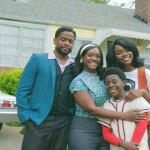How Gender and Race Shaped Stacey Abrams’ Campaign to Court Black Male Voters
Cultural Political Communication
The Voting Rights Act of 1965 opened the doors for Black women to enter politics in the 20th century. And though they have made significant gains in the last 60 years, Black female politicians still face overwhelming racism, sexism and derision, even from some Black men.
Stacey Abrams, an astute politician, understood this dynamic in her 2022 Georgia gubernatorial bid and launched her own internal campaign to court Black male voters, which is known as “Stacey and the Fellas.” She learned well from her 2018 campaign that garnered overwhelming support, 97%, from Black women voters but only 88% from Black men.
New research from University of Florida College of Journalism and Communications examines how Abrams’ 2022 campaign initiative attempted to address this gap amid the complex intersections of race, gender and political discourse.
The study by Journalism Assistant Professor Rachel Grant and doctoral student Nikki Lyons examined 273 tweets related to Abrams’ campaign between June and November 2022.
The team also used a “misogynoir” theoretical framework to analyze social media conversations surrounding Abrams’ targeted outreach to Black male voters. “Misogynoir” is a term created by author, activist and academic Moya Bailey that describes how racism and sexism contribute to the oppression of Black women. Only a handful of scholarly papers have used the lens of misogynoir to deconstruct political discourse.
The researchers’ analysis revealed three key discourse patterns: the impact of racialization, the masculinity of blackness and the presence of misogynoir in the election.
First, discussions of race highlight how political spaces remain steeped in racism while simultaneously erasing Black men’s perspectives. The campaign underscored the fact that racism still very much affects Black men’s lives, while demonstrating that Abrams’ own racial identity also is deeply rooted in the same experiences of discrimination.
Second, the discourse around Black masculinity shows how the campaign attempted to redefine mainstream perceptions of Black male identity. Through events featuring celebrities like Big Tigger, Charlamagne tha God and 21 Savage, the campaign elevated Black male points of view, allowing men to represent themselves with complexity outside of traditional stereotypes.
However, the researchers discovered that some Black men who publicly supported Abrams faced ridicule for not performing traditional masculinity. Social media comments implied these men were “feminine” or “weak” for supporting a female candidate, revealing how deeply misogynoir is embedded in political discourse.
The third key finding centers on how misogynoir manifested in attacks targeting both Abrams’ race and gender. Based on these enmeshed identities, her qualifications were frequently questioned. While supporters emphasized her credentials — including her Yale Law degree and leadership experience — critics often focused on her gender rather than her say on policy.
The study concludes that while the “Stacey and the Fellas” campaign represents an innovative approach to addressing misogynoir in political outreach, it also exposes how prejudice remains entrenched in American politics. The researchers note this is not unique to Abrams, as Black women politicians face similar challenges across the political landscape.
The findings have implications for understanding how social identities and media exposure shape attitudes toward candidates from marginalized groups. As the researchers note, bridging America’s political divides may require addressing both media portrayals and deeper questions of race and gender in political leadership.
The original article, “Focusing on the fellas: Stacey Abrams’ social media campaign addresses misogynoir in U.S. politics,” was published in Communication, Culture and Critique on Nov. 29, 2024.
Authors: Rachel Grant and Nikki Lyons.
This summary was written by Gigi Marino.
Posted: January 10, 2025
Insights Categories:
Cultural, Political Communication
Tagged as: Black voters, Misogynoir, Nikki Lyons, Rachel Grant, Stacey Abrams


